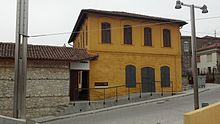Soufli Silk Museum
The silk museum in Soufli ( Greek Μουσείο Μετάξης ) shows all phases and stages of silkworm rearing and the pre-industrial process of silk processing . It also covers the social and economic background that made the region a major silk production center in Greece from the late 19th century to the mid 20th century . The museum belongs to the network of the cultural foundation of the Piraeus Bank Group (Πολιτιστικό Ίδρυμα Ομίλου Πειραιώς).
Museum building
The museum is located in the Kourtidis mansion , built in 1883 , a typical example of Thrace bourgeois architecture. In 1976, the owner's daughter donated the building for use as a silk museum. From 1986 systematic historical, ethnological and architectural research was carried out to use the building for a permanent exhibition on silk production and silk production. The museum was opened in 1990 and temporarily closed in 2007 for the renovation of the premises, the addition of the upper floor and the redesign for a permanent exhibition. The restoration was carried out in the style of the time using contemporary materials. The permanent exhibition has been equipped with modern technologies since it reopened in 2009.
exhibition
On the ground floor, the new permanent exhibition is dedicated to the history of silk and its role for the city of Soufli as the center of the silk industry up to the middle of the 20th century. Integrated, two audiovisual presentations show the role of silk as a timeless element of material culture and the historical, geographical and ecological relationship to the city. A multi-purpose room is attached.
On the upper floor pre-industrial techniques of silk production and the breeding of silkworms are shown and the importance of silkworm breeding for the region is shown. This exhibition is divided into four units:
- The first showroom tells the story of silk, starting with China and spreading through ancient Greece and Rome and the stages in the Byzantine and Ottoman empires .
- In the second room, the different stages of development of silkworm breeding are shown, from the rearing of the caterpillars from the "silk seeds" to the boiling of the cocoons .
- In the third room, the production of silk is shown: the cleaning and sorting of the cocoons and the weaving of fine silk, as was done in Soufli earlier.
- In the fourth room, the larger socio-economic background of silk production is examined as it developed in Greece and the rest of Europe in the 19th and 20th centuries.
Web links
- The Piraeus Bank Group Cultural Foundation silk museum .
- Silk Museum Ministry of Culture and Sports
Coordinates: 41 ° 11 ′ 40 " N , 26 ° 18 ′ 2.6" E
